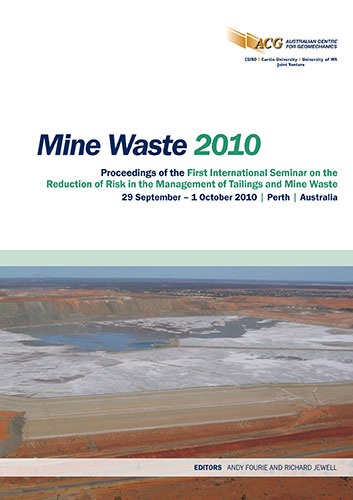Rapid on-site screening for historic contamination at mine sites

|
Authors: Pearce, SR; McKay, K |
DOI https://doi.org/10.36487/ACG_rep/1008_32_Pearce
Cite As:
Pearce, SR & McKay, K 2010, 'Rapid on-site screening for historic contamination at mine sites', in R Jewell & AB Fourie (eds), Mine Waste 2010: Proceedings of the First International Seminar on the Reduction of Risk in the Management of Tailings and Mine Waste, Australian Centre for Geomechanics, Perth, pp. 375-385, https://doi.org/10.36487/ACG_rep/1008_32_Pearce
Abstract:
GHD and Newcrest Mining Limited (Newcrest) have carried out a large scale assessment of rapid on-site screening (ROSS) technology using a portable x-ray fluorescence (XRF) analyser (model type: Niton XL3T) as part of the Newcrest contaminated land assessment programme for expansion of a mine site. The XRF analyser was used to determine concentrations of metals across a number of old workshop and plant areas of the site to seek to delineate any potential impact in near surface soils and aid management decisions regarding both the scale of potential impact and the requirements for materials management. A dual assessment was undertaken in which traditional soil sampling and laboratory analysis was carried out in conjunction with in situ XRF sampling to allow a direct comparison between the two techniques. As would be expected the ROSS survey carried out proved to be significantly quicker than taking soil samples and dispatching to Perth for laboratory analysis, with an average sampling time of two minutes per sample location. This reduced sampling time allowed GHD to significantly increase the sampling density in comparison to conventional soil sampling. In addition, the XRF technology utilises global positioning system (GPS) information which, when used with a portable computer, allows the immediate download of data to geographical information software (GIS) and presentation of results on a geo-referenced map in the field. The turnaround time from data collection to data presentation using this technology is therefore reduced to a single day, allowing ‘real-time’ review and modification of the sampling strategy which would not otherwise have been possible using traditional laboratory based analysis. A robust understanding of the distribution of contamination on a given site is critically important when calculating volumes of material as part of materials management to avoid overestimating quantities of impacted material that may require separation or special treatment. The increased sampling density that can be achieved using ROSS when compared to traditional investigation techniques results in a more detailed understanding of the distribution of contamination both at the micro (or intra sample) and macro (or inter sample) scale, which will improve confidence levels with respect to calculating volumes of potentially impacted material. The study carried out by GHD and Newcrest indicates that in situ screening using ROSS for characterisation of contamination on a large scale mine site is valid and is cost and time effective at the investigation stage, particularly at remote site locations. ROSS offers potentially significant cost and time savings when carrying out works to delineate areas of impacted materials and will aid operational decision making with respect to efficient materials handling and waste management. In addition, the large sampling densities that can be achieved using the ROSS technique allows a more robust estimation of the distribution of contamination than can be achieved with a traditional laboratory based sampling programme of comparable cost.
References:
Contaminated Land: Applications in Real Environments (CLAIRE) (2004) Technical Bulletin TB7, Improving the
Reliability of Contaminated Land Assessments using Statistical Methods Part 1 - Basic Principals and Concepts,
United States Environmental Protection Agency (USEPA) (2007) Method 6200: Field Portable X-Improving
Fluorescence Spectrometry for the Determination of Elemental Concentrations in Soil and Sediment, Rev 0,
Rapid on-site screening for historic contamination at mine sites S.R. Pearce and K. McKay
386 Mine Waste 2010, Perth, Australia
© Copyright 2026, Australian Centre for Geomechanics (ACG), The University of Western Australia. All rights reserved.
View copyright/legal information
Please direct any queries or error reports to repository-acg@uwa.edu.au
View copyright/legal information
Please direct any queries or error reports to repository-acg@uwa.edu.au